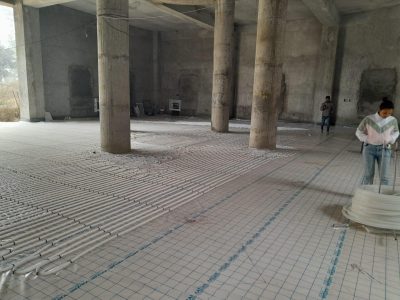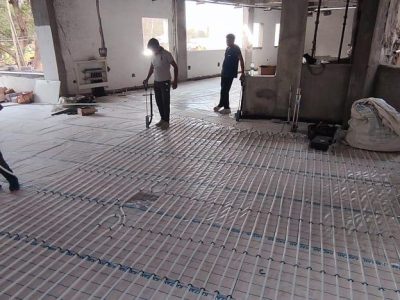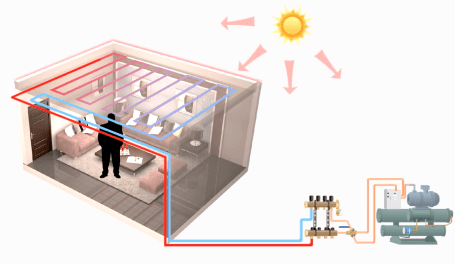Radiant Cooling
A Deep Dive into Technology, Applications, and Sustainability
Scorching heatwaves, more and more intense droughts, wildfires and other weather extremes, the signs of the climate crisis are all around us. Can sustainable cooling help beat the heat while cutting emissions? Rethinking how we stay cool could contribute to tackling today’s cooling paradox – in which heatwaves and extreme temperatures caused by the climate crisis send people in many parts of the world rushing to switch on air conditioning units, which release gases that contribute to climate change.
Sustainable Cooling & Heating through water that saves on carbon footprint, and saves on cost




What is sustainable cooling?
As the name suggests, sustainable cooling is more climate-friendly than traditional refrigeration. It targets efficiency improvements to cooling solutions alongside measures that lower ambient temperatures in buildings and urban environments.


Why is sustainable cooling important?
Traditional air conditioners and refrigerants contain fluorinated gases that can leak, depleting the planet’s ozone layer and harming the environment. Sustainable cooling replaces these gases with climate-friendly alternatives, which when coupled with enhanced energy-efficiency measures reduce both direct emissions from refrigerant leakage and indirect emissions from the energy used to power the cooling unit.
Radiant Cooling –
The Future of Cooling

Radiant Cooling redefines cooling by employing Heat Transfer instead of traditional air conditioning methods. Panels strategically installed in Ceilings, Floors, or Walls absorb heat through Radiative Heat Exchange, transferring it away via a circulating fluid—usually Water or Water-Glycol mixture. This energy-efficient solution rejects heat to the environment through a Chiller or Heat Exchanger.
Amidst rising global temperatures and heightened environmental concerns, traditional AC systems face increased scrutiny. Radiant Cooling emerges as a compelling alternative, utilizing Natural Thermal Radiation to provide comfort without the environmental burden of conventional AC. It represents not just a cooling technology but a versatile revolution. As we strive for a greener future, Radiant Cooling steps into the spotlight as a powerful and innovative solution for energy-efficient and comfortable cooling.”
Beyond Comfort
Quantifiable Advantages of Radiant Cooling
The benefits of Radiant Cooling extend far beyond creating a comfortable environment
Energy Efficiency
Reduced energy consumption, studies have shown that Radiant Cooling can achieve energy savings of 40-90% compared to Traditional Air Conditioning systems.
Lower Operating Costs
Radiant Cooling offers significant cost savings, making it a financially attractive option with expenses less than 50-80% of traditional methods.
Reduced environmental impact
By utilizing less energy, Radiant Cooling reduces greenhouse gas emissions and contributes to a more sustainable future.
Even temperature distribution
Even temperature distribution By utilizing less energy, Radiant Cooling reduces greenhouse gas emissions and contributes to a more sustainable future.
Draft-free cooling
Unlike Air Conditioning Systems that blow cold air, Radiant Cooling operates silently and provides draft-free cooling, preventing discomfort.
Reduced noise pollution
The absence of noisy fans and compressors contributes to a quieter and more peaceful indoor environment.
Improved Air Quality
Radiant Cooling enhances indoor air by reducing pollutants, ensuring a healthier environment, especially in urban areas.
Reduced dust circulation
Radiant Systems eliminate the need for air circulation, leading to significantly lower dust levels and improved air quality.
Reduced allergens
Lower dust levels also mean fewer allergens in the air, creating a healthier environment for allergy sufferers.
Improved respiratory health
Cleaner air reduces the risk of respiratory problems, leading to a Healthier Indoor Environment for everyone.
Discover Bootes’ Environment Breakthroughs
Unveiling the Real-World Impact of Radiant Cooling by BOOTES
Challenge
Design and build a library that achieves Net-Zero Energy Consumption, showcasing cutting-edge Green Technology while fostering Learning and Community Development.
Solutions Implemented
- Radiant Cooling & Heating Technology is employed as the primary cooling solution, eliminating the need for energy-intensive Air Conditioning systems. Next-Generation Heat Pump Technology powered by Solar Energy ensures Optimal Cooling and Heating with Minimal Energy Consumption.
- 100% On-site Renewable Energy generation through Solar PV Panels and a Wind Turbine eliminates reliance on Fossil Fuels.
- Sophisticated Building Management Systems optimize Energy Efficiency and Reduce the Environmental Footprint.
Impact Created
- First and only Net-Zero library in India, generating 100% of its energy on-site.
- Up to 85% reduction in carbon emissions, equivalent to taking 50 cars off the road.
- Up to 60% reduction in Energy Consumption compared to traditional systems.
- Up to 80% reduction in annual electricity consumption for HVAC.
- Up to 60% reduction in electricity bill compared to traditional systems.
- Reduced Airborne Disease transmission.
- Improved Air Quality.
Case Study 2
Geeta Museum,
Kurukshetra, India
- Kurukshetra, Haryana, India


Challenge
Design and build Net-Zero Energy Museum.
Solutions Implemented
Radiant Cooling & Heating System: The underfloor radiant system self-regulates and balances energy within the museum. A Bio-CNG Chiller System provides efficient cooling, reducing its dependence on conventional energy sources. This innovative system utilizes Biogas or Electric Systems supplemented by Solar Energy. This approach Significantly Reduces Energy Consumption (70%) and Carbon Emissions (85%), relying solely on on-site renewable energy generation. Additionally, the air handling unit boasts an Energy Recovery System that Recovers up to 80% of Waste Energy.
Impact Created
- Meeting 100% of the museum’s Overall Cooling Demand.
- Up to 70% reduction in Carbon Emission, equivalent to taking 600 cars off the road.
- Up to 70% reduction in Energy Consumption compared to traditional systems.
- Up to 50% Electrical load Reduction compared to traditional systems.
- Up to 80% of the waste energy recovered.
The Future of Cooling
Radiant Cooling’s Versatility Opens Up A Vast Array Of Application Possibilities

Residential Homes
Cooling offers a comfortable and Energy-Efficient solution for all living spaces.

Commercial Buildings
Offices, schools, hospitals, and even data centers can benefit from Radiant Cooling's efficiency, comfort, and improved air quality

Industrial Facilities
Precise temperature control and reduced dust circulation make Radiant Cooling ideal for manufacturing processes and product quality control.

Hospitality Venues
Hotels, restaurants, and other hospitality establishments can create a pleasant and inviting atmosphere for their guests with unobtrusive and efficient Radiant Cooling & Heating.
The
BOOTES Edge
BOOTES is at the forefront of the construction industry’s shift towards sustainable and green building practices. Our strength lies in our ability to undertake turn-key projects, from design and engineering to construction and project management. Moreover, we champion Net-Zero implementation, contributing to the realization of self-sufficient and sustainable infrastructure.
At BOOTES, we don’t just build structures; we forge a future where innovation and sustainability converge seamlessly. Our commitment to sustainability is reflected in our use of cutting-edge technology and innovative construction models, which are environmentally friendly and energy-efficient.
- Implementing energy efficiency measures in buildings to reduce energy consumption and costs.
- Utilizing world-class technology such as hydronic systems, efficient energy storage, high-temperature cooling & low-temperature heating, and carbon capture to achieve carbon-neutral/positive buildings.
- Integrating renewable energy sources such as solar, wind power, and biofuels to reduce reliance on fossil fuels in our infrastructure.
- Integrating Zero-liquid discharge & Zero-waste systems for water conservation and waste management.
- Using sustainable materials and construction practices inspired by ancient Indian architecture.
- Collaborating with stakeholders including governments, businesses, and communities to ensure buy-in and support for net-zero infrastructure initiatives.
With Net-Zero infrastructure, we deliver reduced carbon footprint and reduced operating costs.



